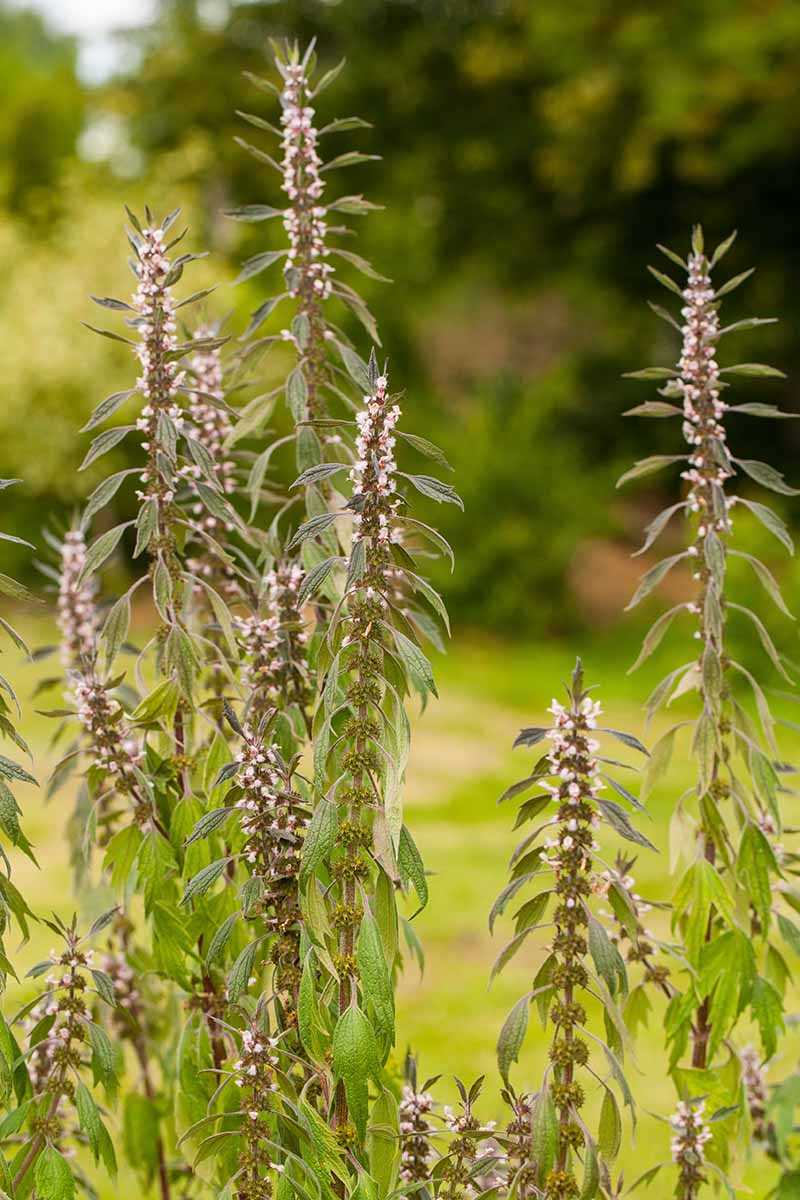- Motherwort Cultivation
- 1. Soil Preparation
- 2. Planting
- 3. Sun and Water
- 4. Maintenance
- 5. Harvesting
- 6. Pests and Diseases
- Choosing the Right Location
- Soil Preparation and Planting
- 1. Selecting the Site
- 2. Soil Testing
- 3. Soil Amendments
- 4. Clearing the Area
- 5. Digging the Soil
- 6. Adding Organic Matter
- 7. Planting
- 8. Mulching
- 9. Watering
- 10. Maintenance
- Watering and Fertilizing
- Pruning and Harvesting
- Pruning Motherwort
- Harvesting Motherwort
- Motherwort Properties
- Medicinal Uses
- Cardiovascular Health
- Menstrual Disorders
- Anxiety and Nervous System
- Digestive Health
- Hormonal Balance
- Caution and Considerations
- Side Effects and Precautions
- Possible Side Effects
- Precautions
- Motherwort Types and Varieties
- 1. Leonurus cardiaca
- 2. Leonurus sibiricus
- 3. Leonurus japonicus
- 4. Leonurus villosus
- 5. Leonurus nepetifolia
- Leonurus cardiaca
- Cultivation
- Types and Varieties
- Conclusion
- Questions and Answers:
- What is motherwort?
- How is motherwort cultivated?
- What are the properties of motherwort?
- What are the different types of motherwort?
- Can you tell me more about the varieties of motherwort?
- Videos: A Leaf a day keeps my MIGRAINES away!
Motherwort, also known as Leonurus cardiaca, is a herbal plant that has been used for centuries in traditional medicine. It is native to Europe and Asia, and is now cultivated in many parts of the world. Motherwort is known for its calming and relaxing properties, and has traditionally been used to treat anxiety, insomnia, and heart conditions.
The cultivation of motherwort is relatively simple, as it can grow in a variety of soil types and climates. It is a perennial plant that can reach up to 6 feet in height, with long stems and pink or purple flowers. Motherwort plants prefer full sun or partial shade, and should be watered regularly.
The properties of motherwort are attributed to its active compounds, including flavonoids and alkaloids. These compounds have been found to have sedative, anti-inflammatory, and cardioprotective effects. Motherwort is often used in herbal teas or tinctures to promote relaxation and reduce anxiety.
There are several types and varieties of motherwort, each with their own unique characteristics. Some popular varieties include Leonurus cardiaca ‘Alba’, which has white flowers, and Leonurus cardiaca ‘Rubra’, which has red flowers. Other types of motherwort include Leonurus japonicus and Leonurus sibiricus, which have similar medicinal properties.
In conclusion, motherwort is a versatile and beneficial herb that can be easily cultivated and used for its calming and medicinal properties. Whether you are looking to reduce anxiety, promote sleep, or support heart health, motherwort may be a valuable addition to your herbal medicine cabinet.
Motherwort Cultivation

Motherwort (Leonurus cardiaca) is a versatile herb that can be grown in a variety of conditions. Here are some tips on how to cultivate motherwort:
1. Soil Preparation
Motherwort prefers well-drained soil with a slightly alkaline pH. Prepare the soil by removing any weeds or debris and loosening it with a garden fork or tiller. Add compost or well-rotted manure to improve the soil’s fertility and drainage.
2. Planting
Sow motherwort seeds directly in the garden in early spring. The seeds are very small, so sprinkle them lightly on the soil surface and lightly press them in. Keep the soil moist until germination occurs, which usually takes 1-3 weeks.
3. Sun and Water
Motherwort grows best in full sun but can tolerate some shade. Water the plants regularly, especially during dry periods, to keep the soil evenly moist. Avoid overwatering, as motherwort can be susceptible to root rot.
4. Maintenance
Once motherwort is established, it requires minimal maintenance. Remove any weeds that compete with the plants for nutrients and water. You can also trim back the plants after flowering to encourage bushier growth.
5. Harvesting
The leaves and flowering tops of motherwort can be harvested for medicinal or culinary purposes. Harvest the leaves before the plant flowers for the best flavor and potency. Hang the stems upside down in a well-ventilated area to dry, then store the dried leaves in an airtight container.
6. Pests and Diseases
Motherwort is generally resistant to most pests and diseases. However, it can be occasionally affected by aphids, spider mites, or powdery mildew. Monitor the plants regularly and use appropriate organic methods to control these issues if necessary.
By following these cultivation tips, you can successfully grow motherwort in your garden and enjoy its many benefits.
Choosing the Right Location

When cultivating motherwort, it is important to select the right location for optimal growth and development. Here are some considerations to keep in mind:
- Sunlight: Motherwort thrives in full sunlight, so choose a location that receives at least 6 hours of direct sunlight per day.
- Soil: Motherwort prefers well-draining soil that is rich in organic matter. Ensure that the soil is loose and can hold moisture without becoming waterlogged.
PH Level: Motherwort grows best in slightly acidic to neutral soil with a pH level between 6.0 and 7.0. Test the soil to determine its pH level and make necessary amendments if needed.- Wind Protection: Motherwort can be sensitive to strong winds, so consider planting it in a location that is sheltered from heavy gusts. This can help prevent damage to the plants and ensure their overall health.
- Space: Motherwort plants can grow quite large, so allow for ample space between each plant. This will enable proper airflow and minimize the risk of disease or pest infestation.
By keeping these factors in mind, you can select an ideal location for cultivating motherwort. Providing the right growing conditions will encourage healthy growth and ensure a bountiful harvest.
Soil Preparation and Planting
Proper soil preparation is essential for the successful cultivation of motherwort. It helps provide the necessary nutrients and a suitable environment for the plants to grow. Here are the steps for soil preparation and planting:
1. Selecting the Site
Choose a sunny location for planting motherwort. The site should receive at least six hours of direct sunlight per day.
2. Soil Testing
Before planting, it is recommended to test the soil to determine its pH level and nutrient content. Motherwort prefers slightly acidic soil with a pH range of 6 to 7.
3. Soil Amendments
If the soil pH is too low or too high, you can amend it by adding organic matter such as compost or well-rotted manure. This will help improve the soil structure and fertility.
4. Clearing the Area
Remove any weeds, rocks, or debris from the planting area. This will help ensure that the motherwort plants have enough space to grow and won’t compete with other plants for nutrients and water.
5. Digging the Soil
Using a garden fork or shovel, dig the soil to a depth of about 12 to 15 inches. Break up any clumps and remove any large stones or roots that may obstruct the growth of the motherwort plants.
6. Adding Organic Matter
Incorporate organic matter like compost or well-rotted manure into the soil. This will improve the soil’s texture, moisture retention, and nutrient content.
7. Planting
Plant the motherwort seeds or seedlings in the prepared soil. The spacing should be about 12 to 18 inches apart to allow enough room for the plants to spread. Gently cover the seeds or roots with soil and water thoroughly.
8. Mulching
Apply a layer of organic mulch, such as straw or wood chips, around the plants. This will help suppress weed growth, conserve moisture, and regulate soil temperature.
9. Watering
Water the motherwort plants regularly, especially during dry periods. Keep the soil moist, but avoid overwatering, as it can lead to root rot.
10. Maintenance

Monitor the plants for pests and diseases. Remove any weeds that may sprout. Prune the plants to maintain their shape and prevent them from becoming too sprawling.
Following these steps for soil preparation and planting will provide a good foundation for growing healthy motherwort plants. Remember to provide regular care and maintenance to ensure their optimal growth and productivity.
Watering and Fertilizing
Motherwort plants generally require a moderate amount of water to thrive. However, it is important not to overwater them as it can lead to root rot. The frequency of watering will depend on factors such as the weather, soil type, and the size of the plant.
Here are some guidelines for watering motherwort plants:
- Water the plants deeply once a week during dry periods.
- Make sure the soil is well-drained to prevent waterlogging.
- Watch for signs of wilting, which indicates that the plant needs water.
- Avoid overhead watering, as it can increase the risk of fungal diseases.
In terms of fertilizing, motherwort plants are not heavy feeders and do not require frequent fertilization. However, applying some fertilizer can help promote healthy growth and flowering. Here are some tips for fertilizing motherwort:
- Apply a balanced organic fertilizer in the early spring before new growth appears.
- Avoid using excessive amounts of fertilizer, as it can lead to excessive leaf growth and reduced flower production.
- Follow the instructions on the fertilizer package for the correct application rates.
- Alternatively, you can use a slow-release fertilizer to provide a steady supply of nutrients over a longer period of time.
By providing the right amount of water and fertilizer, you can ensure that your motherwort plants grow healthy and produce abundant flowers.
Pruning and Harvesting
Motherwort is a perennial herb that requires regular pruning in order to keep it healthy and productive. Additionally, knowing when and how to harvest the plant is essential to ensure maximum potency and quality of the medicinal properties it possesses.
Pruning Motherwort
Pruning motherwort is necessary to keep the plant from becoming too woody and sprawling. It is generally recommended to prune motherwort in early spring before new growth appears or after the first flush of flowers has finished blooming.
To prune motherwort:
- Begin by removing any dead, damaged, or diseased stems and leaves. These should be cut back to the base of the plant.
- Next, selectively remove any overcrowded stems to improve air circulation and reduce the risk of disease.
- Trim back the remaining stems to maintain a compact and bushy shape.
Regular pruning will help to keep motherwort healthy and productive, ensuring a bountiful harvest of leaves and flowers.
Harvesting Motherwort
The timing of the harvest is crucial to ensure the highest concentration of medicinal compounds in the motherwort plant. The best time to harvest motherwort is when the plant is in full bloom.
To harvest motherwort:
- Using clean and sharp pruning shears, cut the stems with flowers just below the flower heads.
- Gently bundle the harvested stems and hang them upside down in a cool, dry, and well-ventilated area.
- Allow the stems to dry fully, which can take several weeks.
- Once completely dry, gently strip the leaves and flowers from the stems and store them in airtight containers away from direct sunlight.
Properly dried and stored motherwort leaves and flowers can be used in various herbal preparations, such as teas, tinctures, and infusions, to harness their medicinal properties.
Motherwort Properties
Motherwort (Leonurus cardiaca) is a perennial herbaceous plant that belongs to the mint family. It is native to Europe and has been used for centuries for its medicinal properties. Here are some of the key properties of motherwort:
- Cardiotonic: Motherwort is widely known for its beneficial effects on the heart. It has been used to treat various heart conditions, including palpitations, rapid or irregular heartbeat, and high blood pressure. It is believed to strengthen and tone the heart muscles, improving overall cardiovascular health. The herb also helps to reduce anxiety and stress, which are often associated with heart problems.
- Sedative: Motherwort has calming and sedative properties that can help relieve anxiety, insomnia, and nervous tension. It is commonly used as a natural alternative to pharmaceutical sedatives and tranquilizers. The herb promotes relaxation and can help induce restful sleep.
- Antispasmodic: Motherwort has a long history of use as a muscle relaxant and antispasmodic. It can help alleviate muscle cramps, menstrual cramps, and abdominal pain. The herb also reduces uterine contractions, making it beneficial for women with painful or irregular periods.
- Digestive Aid: Motherwort stimulates digestive function and promotes healthy digestion. It can help alleviate indigestion, bloating, and gas. The herb also has a mild diuretic effect that helps to eliminate excess fluid from the body.
- Anti-inflammatory: Motherwort contains compounds that have anti-inflammatory properties. It can help reduce inflammation in the body and may be beneficial for conditions such as arthritis, gout, and inflammatory bowel disease.
- Antioxidant: The herb is rich in antioxidants, which help protect the body from oxidative stress and damage caused by free radicals. Antioxidants promote overall health and may help prevent chronic diseases.
- Hormonal Balance: Motherwort has been traditionally used to regulate hormonal imbalances, particularly in women. It can help reduce symptoms of premenstrual syndrome (PMS), including mood swings, irritability, and breast tenderness. The herb may also have a positive effect on menopausal symptoms, such as hot flashes and night sweats.
In addition to these properties, motherwort is also believed to have antibacterial, antiviral, and antifungal properties. It is a versatile herb that can be used in various forms, including teas, tinctures, and capsules. However, it is always recommended to consult with a healthcare professional before using motherwort or any other herbal remedy.
Medicinal Uses
Motherwort has been used for centuries in traditional medicine for its various medicinal properties. It contains active compounds such as alkaloids, flavonoids, and terpenes, which contribute to its therapeutic effects.
Cardiovascular Health
One of the main traditional uses of motherwort is for maintaining cardiovascular health. It is known to have cardiotonic properties, which help strengthen the heart and improve its overall function. Motherwort can help regulate heart rate, lower blood pressure, and reduce palpitations.
Additionally, motherwort is believed to possess anticoagulant properties, which may help prevent the formation of blood clots and improve blood circulation. This can be beneficial for individuals with conditions such as atherosclerosis, thrombosis, and varicose veins.
Menstrual Disorders
Motherwort is commonly used to address various menstrual disorders. It has emmenagogue properties, which means it can stimulate or normalize menstrual flow. It is often used to relieve menstrual cramps, regulate irregular periods, and reduce the symptoms of premenstrual syndrome (PMS).
Furthermore, motherwort is known to have mild sedative and antispasmodic properties. This can help alleviate menstrual pain, reduce uterine spasms, and promote relaxation during menstruation.
Anxiety and Nervous System
Motherwort is often used as a natural remedy for anxiety and nervous system disorders. It has been shown to have mild sedative and anxiolytic effects, which can help calm the nerves and promote relaxation. It may also be beneficial for individuals experiencing restlessness, irritability, or insomnia.
In addition, motherwort is believed to have mild antidepressant properties. It can help uplift the mood and improve overall mental well-being.
Digestive Health
Motherwort has been used to support digestive health and relieve digestive disorders. It can help stimulate appetite, improve digestion, and alleviate symptoms such as bloating, gas, and indigestion.
Furthermore, motherwort is known to have mild diuretic properties, which can help promote urination and remove excess fluids from the body. This may be beneficial for individuals with edema or water retention.
Hormonal Balance
Motherwort is also used to support hormonal balance, particularly in women. It can help regulate hormone levels, promote healthy menstrual cycles, and reduce symptoms associated with hormonal imbalances such as hot flashes and mood swings.
Additionally, motherwort is believed to have mild estrogenic properties. This can be beneficial for women experiencing menopausal symptoms or hormonal fluctuations.
Caution and Considerations
While motherwort is generally safe for most people when used appropriately, it is important to consult with a healthcare professional before using it, especially if you have any existing medical conditions or are taking medication.
It is recommended to start with a low dosage and gradually increase if needed. Motherwort may interact with certain medications, such as anticoagulants or blood pressure medications, so it is important to seek medical advice if you are on any prescribed medications.
Pregnant women should avoid using motherwort, as it may stimulate uterine contractions. Breastfeeding women should also consult with a healthcare professional before using motherwort.
Overall, motherwort can be a valuable herbal remedy for various health conditions, but it is important to use it responsibly and under appropriate guidance.
Side Effects and Precautions
Motherwort is generally safe for most people when taken by mouth or applied topically. However, like any other herbal remedy, it may cause some side effects in certain individuals.
Possible Side Effects
- Gastrointestinal discomfort: Some people may experience mild stomach upset, nausea, or diarrhea after consuming motherwort. If these symptoms are persistent or severe, it is advisable to discontinue its use and consult a healthcare professional.
- Allergic reactions: In rare cases, motherwort may cause allergic reactions in sensitive individuals. Symptoms may include skin rash, itching, swelling, or difficulty breathing. If any signs of an allergic reaction occur, immediate medical attention should be sought.
- Low blood pressure: Motherwort has a mild hypotensive effect and may lower blood pressure. Individuals with already low blood pressure or those taking medications to lower blood pressure should use motherwort with caution and monitor their blood pressure regularly.
- Increased bleeding risk: Motherwort may have anticoagulant properties and could increase the risk of bleeding. People with bleeding disorders or those taking blood-thinning medications should avoid motherwort or consult a healthcare professional before using it.
Precautions
It is important to take certain precautions when using motherwort:
- Pregnancy and breastfeeding: Motherwort is not recommended for pregnant or breastfeeding women due to limited safety information. It may stimulate uterine contractions and potentially cause miscarriage or harm to the fetus. It is always best to consult a healthcare professional before using any herbal remedies during pregnancy or while breastfeeding.
- Surgery: Motherwort may affect blood clotting and increase the risk of bleeding during and after surgery. It is advised to stop using motherwort at least two weeks before a scheduled surgery.
- Interaction with medications: Motherwort may interact with certain medications, including anticoagulants, antiplatelet drugs, sedatives, and thyroid medications. It is essential to inform your healthcare provider about all medications and supplements you are taking before starting motherwort.
- Quality and dosage: Ensure that you obtain motherwort from a reputable source and follow the recommended dosage. Excessive use or use of poor-quality motherwort may lead to adverse effects and compromised efficacy.
As with all herbal remedies, it is advisable to consult a healthcare professional before using motherwort, especially if you have any underlying medical conditions or are taking medications.
Motherwort Types and Varieties
Motherwort is a medicinal plant that belongs to the mint family (Lamiaceae). There are several types and varieties of motherwort that are commonly grown and used for their therapeutic properties. The most popular ones include:
1. Leonurus cardiaca
This is the most common and widely cultivated type of motherwort. It is native to Europe and Asia and has been used for centuries in traditional medicine. Leonurus cardiaca is known for its calming and sedative effects on the nervous system, making it a popular choice for treating anxiety and insomnia.
2. Leonurus sibiricus
This type of motherwort is native to Siberia and other parts of northern Asia. It is often used in traditional Chinese medicine for its analgesic and anti-inflammatory properties. Leonurus sibiricus is also believed to have a positive effect on the cardiovascular system and can help regulate blood pressure.
3. Leonurus japonicus
Leonurus japonicus is native to East Asia, including Japan and China. It is commonly used in Korean traditional medicine for its diuretic properties and to treat conditions such as edema and urinary tract infections. This type of motherwort is also believed to have antioxidant and anti-cancer effects.
4. Leonurus villosus
Native to North America, Leonurus villosus is often referred to as hairy motherwort due to the fine hairs that cover its leaves and stems. It is commonly used in Native American traditional medicine as a diuretic and to promote menstruation. This type of motherwort is also known for its pain-relieving properties.
5. Leonurus nepetifolia
Leonurus nepetifolia is native to tropical and subtropical regions of the Americas. It is commonly used in traditional Ayurvedic medicine for its calming and antispasmodic effects. This type of motherwort is also believed to have antimicrobial properties and can be used topically to treat skin infections.
These are just a few examples of the types and varieties of motherwort. Each type has its own unique properties and uses, but they all share a common reputation for their medicinal benefits. Whether you are using it as a tea, tincture, or in other forms, motherwort can be a valuable addition to your natural health routine.
Leonurus cardiaca

Leonurus cardiaca, commonly known as motherwort, is a herbaceous perennial plant in the mint family, Lamiaceae. It is native to Europe and central Asia, but has now naturalized in North America. The plant is named “motherwort” due to its traditional use in providing support to women during childbirth and relieving menstrual symptoms.
Motherwort has a long history of medicinal use in traditional medicine systems, including Traditional Chinese Medicine (TCM) and Western herbal medicine. It has been used to calm the nervous system, reduce anxiety and stress, promote relaxation, and support heart health. It is also believed to have anti-inflammatory, antispasmodic, and diuretic properties.
Cultivation

Motherwort is an easy plant to cultivate and can be grown in a variety of soil types. It prefers full sun to partial shade and well-draining soil. The plant can be propagated from seeds or by dividing the root ball. It is a hardy plant that is resistant to pests and diseases.
When planting motherwort, it is recommended to space the plants about 18 inches apart to allow for proper growth. The plant can reach heights of 3 to 5 feet and should be watered regularly to keep the soil moist. Mulching around the base of the plant can help retain moisture and suppress weeds.
Types and Varieties
There are several different varieties of motherwort available, each with its own unique characteristics. Some popular varieties include:
- Leonurus cardiaca: This is the most common and widely cultivated variety of motherwort. It has pink or white flowers and deeply lobed leaves.
- Leonurus cardiaca ‘Alba’: This variety has white flowers and is known for its calming properties. It is often used in herbal remedies for anxiety and sleep disorders.
- Leonurus cardiaca ‘Villosus’: This variety has hairy leaves and a stronger medicinal effect compared to other varieties.
Conclusion
Motherwort, or Leonurus cardiaca, is a versatile and valuable plant that has been used for centuries in traditional medicine. It is a hardy plant that is easy to grow and offers a range of health benefits. Whether you are looking to support heart health, relieve anxiety, or promote relaxation, motherwort may be a beneficial addition to your herbal medicine cabinet.
Questions and Answers:
What is motherwort?
Motherwort is a medicinal herb that belongs to the mint family, known for its calming and therapeutic properties.
How is motherwort cultivated?
Motherwort can be cultivated through seeds or root division. It requires well-drained soil and full sun to partial shade for optimal growth.
What are the properties of motherwort?
Motherwort has various properties including sedative, diuretic, antispasmodic, and emmenagogue. It is also known for its ability to support cardiovascular health and relieve menstrual cramps.
What are the different types of motherwort?
There are several types of motherwort, including Leonurus cardiaca (common motherwort), Leonurus sibiricus (Chinese motherwort), and Leonurus japonicus (Japanese motherwort).
Can you tell me more about the varieties of motherwort?
There are several varieties of motherwort, each with its own unique characteristics. Some popular varieties include Leonurus cardiaca ‘Alba’ (white motherwort) and Leonurus cardiaca ‘Villosus’ (hairy motherwort).







